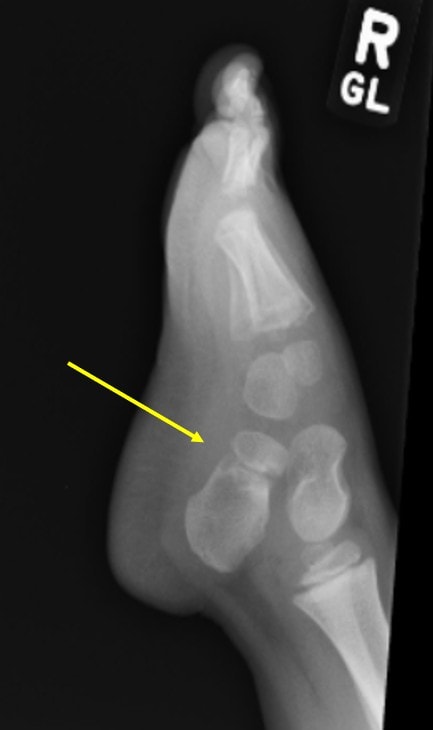Differential Diagnosis
- Accessory calcaneal ossification center
- Calcaneal duplication
- Calcaneus secundarius
- Fracture of the anterior process o the calcaneus

Diagnosis
The findings in this case were not trauma-related, but an incidental finding of a normal variation of ossification of calcaneal body with two separate ossification centers. Typically, there is only a single ossification center; presence of two separate ossification centers should not be mistaken for a fracture.
This patient was diagnosed with calcaneal duplication/accessory calcaneal ossification center. This is a rare occurrence in which a secondary separate ossification center develops during the developmental phase of childhood. Primary and secondary calcaneal ossification centers usually develop at 6 months in utero and 5 years of age, respectively.
Learnings/What to Look for
- The x-ray shows a large, abnormal ossified bony structure at the level of anterior process of calcaneus separated from the main calcaneal body ossification center by a lucent zone of synchondrosis. The opposing bony surfaces have sclerotic borders
- Primary center is usually centrally located, and the secondary center along the posterior surface
- Rarely, an additional ossification center develops in the anterior calcaneus, either as an isolated phenomenon or as part of rare skeletal dysplasia
- The secondary ossification center is usually asymptomatic and is separated from the primary center by a lucent cartilaginous zone
- Two ossification centers usually fuse during the childhood without any residual deformity or structural anomaly
Pearls for Urgent Care Management
- Patients experiencing pain due to this condition should be referred to a pediatric orthopedist for further evaluation and possible treatment
- No treatment is indicated for asymptomatic patients
Acknowledgment: Image and case presented by Experity Teleradiology (www.experityhealth.com/teleradiology).
